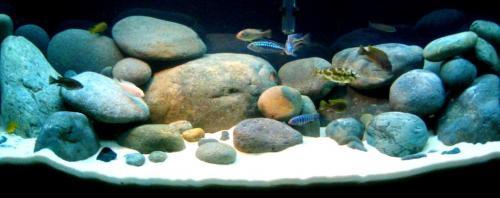Setting up a Lake Malawi Cichlid Tank
Setting up your cichlid tank
Malawian cichlids have three general living preferences: rocky, sandy or mid-water. Use smooth rocks and pile them up to form caves and hideaways for them to take refuge in. As most Cichlids are teritorial it's wise to create as many caves and hideaways as possible.Make sure all rockwork is secure and start building the rockwork from the base of the tank rather than from the substrate.
Rockwork can be bonded together using aquarium safe epoxy or aquarium glue.
Your Substrate should just cover the bottom of your tank as some cichlids like to dig and they will make piles of sand all along the bottom of the tank so having too much Sand will make for all kinds of unsightly heaps.

Lake Malawi Cichlid Temperature
Like most Tropical Fish Cichlids are very hardy but they do not do well if there are great fluctuations in temperature. Lake Malawi has water temperatures that vary from 70 to 80 degrees so a heater is essential Smaller tanks can go with a single heater, whereas larger tanks should use two. Follow the rule of 3 watts per gallon and don't forget to get an accurate thermometer and place the thermometer away from the heater.
Cichlid Filtration
As Cichlid tanks work better with a good volume of fish you will need to have excellent filtration. In fact, we can't stress this enough.
A canister filter is highly recommended. Make sure the canister filter can cope with your tank size, infact with a cichlid tank slightly oversizing will cover you for that extra waste the fish will produce and it will add extra water volume. Make sure you clean the canister filter regularly and always clean sponges using old aquarium water so as not to kill of the beneficial bacteria.
African Cichlid Lighting
Most Malawian cichlids live deep in the lake so light is minimul, so to try and keep to their natural habitat don't over do it with the lighting. One bulb is recommended or one LED unit depending on tank size. If you want to really make the blue color in these fish stand out then you need to add a blue actinic bulb.
As like all other fish tanks you want to keep a good living balance so attach your lights to a timer, so lights come on and of around the same time everyday. Duration of lighting is your preferance but i would say to go for around 7 to 8 hours of light.
Lake Malawi Cichlid Water Chemistry
The pH in Lake Malawi ranges from 7.8 to 8.5 which is moderately high.
As we are wanting to try and re-creatie the natural habitat you should aim for this pH level. Invest in a pH test kit to aid in testing your tank water and the water you will add on a regular basis through water changes. You can add pH adjusters to your water to alter the ph up or down, but make sure you adjust pH slowy in your tank otherwise the fish will suffer pH shock.
Water hardness is important to consider as well. The kH of Lake Malawi is between 12 and 13. Again you may need to measure the hardness of your water using a kH test kit. If your kH is low you will need to raise the hardness. A thin layer of crushed coral sand is a great way to keep the water on the alkaline side. It will continually leach out minerals into the water or you can add buffering agents
Cichlid Feeding
Like all fish keeping you will want to make sure you feed your fish the best possible diet with plenty of vitamins and minerals. Feeding a high quality diet will go a long way in keeping your fish happy and healthy. Try mixing foods so your fish gets a good varied diet.
Cichlid Water Changes
The single most important thing to do with an aquarium is to do regular water changes. Water changes can be done weekly or bi-weekly. If you overcrowd your tank with cichlids then it is recommended that you do around a 40% to 50% water change weekly otherwise you can keep to around 10% - 15% a week. Add conditioner to your new water to dissipate chlorine and heavy metals from the water.
Use a siphon to remove all the feces at the bottom of the aquarium. It is also good to clean your filter pads at this time. If they are old replace them with new ones, but if they are still newer then dip them into the old water that has been removed from the tank. This way the nitrifying bacteria will not be harmed and put the original filter pad back into the filter.
Try and make your new water as close to the tank parameters as possible as if doing big water changes with incorrect water your parameters will change too quickly stressing your fish.
Never put in cold water!
Good luck and make sure all rockwork is secure !
Happy Fishkeeping
Holiday Aquatics
www.holidayaquatics.com
No comments:
Post a Comment